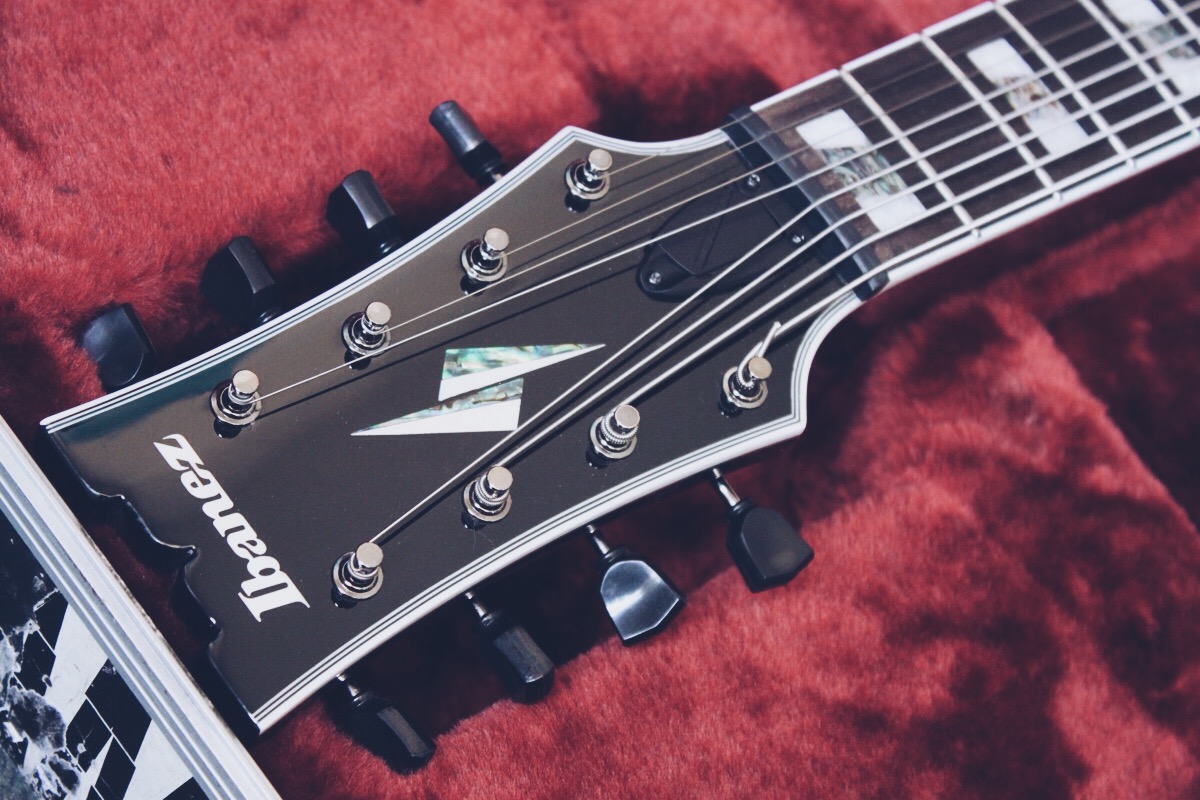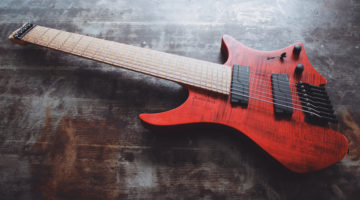Editor's Rating
Classic looks vs. fast playability? The Ibanez ARZIR28 can do both.
Ibanez are most widely known for their RGs, but among the less popular shapes they offer, you will find a lot of models with a more classic approach. There is the FR series, for example – a really cool singlecut design that resembles the look of a Telecaster and begs for a 7-string execution. You hear me, Ibanez?! And there also is the ARZ series – a tweaked Les Paul type of shape that has been extended over the last few years.
The ARZ is essentially a more “Metal”-friendly take on the Les Paul design. It has the classic looks but offers faster playability, higher output pickups and design tweaks that make it look more “brutal”. In 2011, Ibanez came out with the 7-string version, in 2014 they added two Iron Label series models and in 2015, now, they are the first manufacturer to mass-produce a Les Paul design with 8 strings – the ARZIR28. Unlike most other Iron Labels, it is made in China, not in Indonesia.
The Specs
- Mahogany body
- Mahogany/Walnut 5P set-in neck
- 27“ scale
- Bound rosewood fretbaord
- Graph Tech TUSQ Nut
- Black finish
- Multi-laminate Binding
- EMG808 set
- 3-way Pickup Selector
- Full-Tone III TOM bridge
Impressions
When I first unboxed the guitar, the absolutely classy appearance of the ARZIR28 really impressed me (but let’s just call this thing “ARZ8” from now on, to make things easier). The glossy black, a color I’m usually not too fond of, looks amazing with the white full body-, neck- and headstock-binding. The Sure Grip III pots, an upgraded speed knob design, the abalone/pearl block inlays of the fretboard and the old school look of the tuners enhance the classy overall look of the ARZ8. But if you take a closer look, you’ll notice that it’s way less bulky than your typical Les Paul. The ARZ is rather sleek, has beautifully slimmed-down curves and a slightly more mean appearance.
Besides this being the first production model Les Paul design with 8 strings, I also think the Tune-O-Matic 8 bridge is a first?! I haven’t seen any guitars with it as of yet. It feels sturdy and is really comfortable to rest your hand on when palm-muting riffs or simply muting the strings. From the factory, the string action was set low enough to make for a really comfy playing experience. That reminded me of the LTD Viper 400 I used to own, which was a true plug & play guitar and didn’t need a thorough setup from the get go. The same goes for the ARZ8 and with the TOM bridge being such an easily adjustable piece of hardware, every player should be able to set up the string action to their liking with no issue whatsoever.
The ARZ comes with a lot of cool features, such as the Graph Tech TUSQ nut, which is something I haven’t seen on a stock Ibanez so far. The hardware and electronics seem allaround solid as well. The 3-way pickup switch operates precise and snappy, the Sure Grip pots look classy and feel valuable.
I’m just not sure about the tuners. Their classic design might be appreciated by some, but it also shows the ambivalence of the ARZ’s design. They don’t seem to operate as precise as a good set of Gotohs for example and the mounting tabs of the highest and lowest string’s tuner also extend over the edge of the headstock’s edge. It’s quite minimal and doesn’t get in the way of your playing, but it’s something that could have been executed with a little more precision. With their plastic wings, they are probably more light-weight, though. So my best guess is that they were chosen to reduce neck-dive, which is definitely tolerable with the ARZ8.
What I was really surprised about was the neck profile. It is a bit thicker and rounder than your average Ibanez Wizard 8 necks, but it feels very comfortable – even to my relatively small hands. It is also finished in glossy black, which is something I personally don’t like so much. The neck joint is a work of art, with a beautiful carve that continues into an inner cutaway scoop – both make higher fret access really easy and also look sleek. The fretwork is pretty much flawless as well, which is something I have found to be the case with most made in China-Ibbys. What isn’t flawless is the binding, but you’ll have to take a real hard look to find the little imperfections here and there.
The Sound
The EMG808s were the first mass-produced 8-string pickups to hit the market and to this day, they sound exactly like a first attempt. The low end is somewhat mushy, the overall sound is dull and lifeless, the bridge model lacks clarity, note- and chord-definition and dynamics. The only thing the EMG808 is good at is really chunky palm-mutes. Yet, it’s established as the go-to 8-string pickup with most guitar brands. EMG can do much better, as the X series shows. But I feel like the industry needs to take note that a lot of people end up swapping these and also that passive pickups are the more popular choice for ERG players these days.
Besides the two clips below, you can compare the EMG808 to a bunch of other pickups in my 8-String Pickup Shootout to see just how inferior they unfortunately are. Long story short, this guitar and any other 8-string production model that comes with them could sound so much better with different stock pickups.
The Verdict
The ARZIR28 really surprised me. The design is appealing and different to most ERGs out there, the hardware and features it comes with are valuable. The biggest selling point of the ARZ8 is its playability, though. It’s a true plug & play instrument and could make diving into the world of 8 strings easier for some people – especially for those coming from Gibson-based designs. The slimmed-down and tweaked Les Paul look of the ARZ looks good and plays fast, also thanks to the comfy neck profile and amazing neck joint.
On the other hand, you have the subpar EMG808s, which – despite being the standard for 8-string guitars among most manufacturers – just don’t perform well. They make the guitar sound dull and lifeless. Which is a shame, given that the rest of the guitar was able to really surprise me. It’s not like you couldn’t upgrade them, but you are left with limited options, thanks to the active-sized pickup routes. I think I’m not alone when I say that most of us ERG players would prefer to see the EMG808s disappear from stock models – tell me what you think about that in the comments below!
All in all, the ARZ is a fun and really solid guitar with a surprising level of quality. For those of you who love ERGs but don’t like the typical superstrat-shapes, I can only recommend to check it out.






















